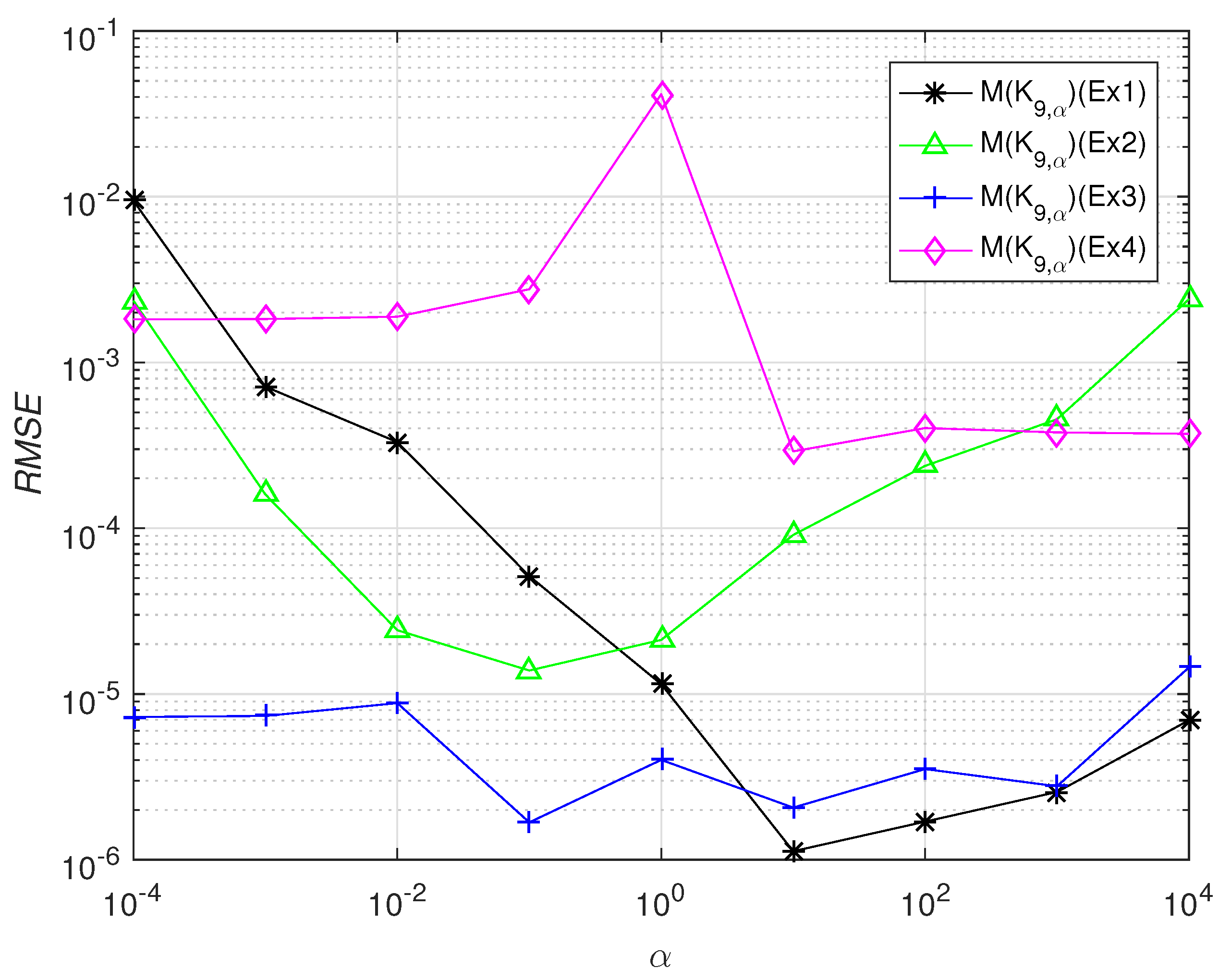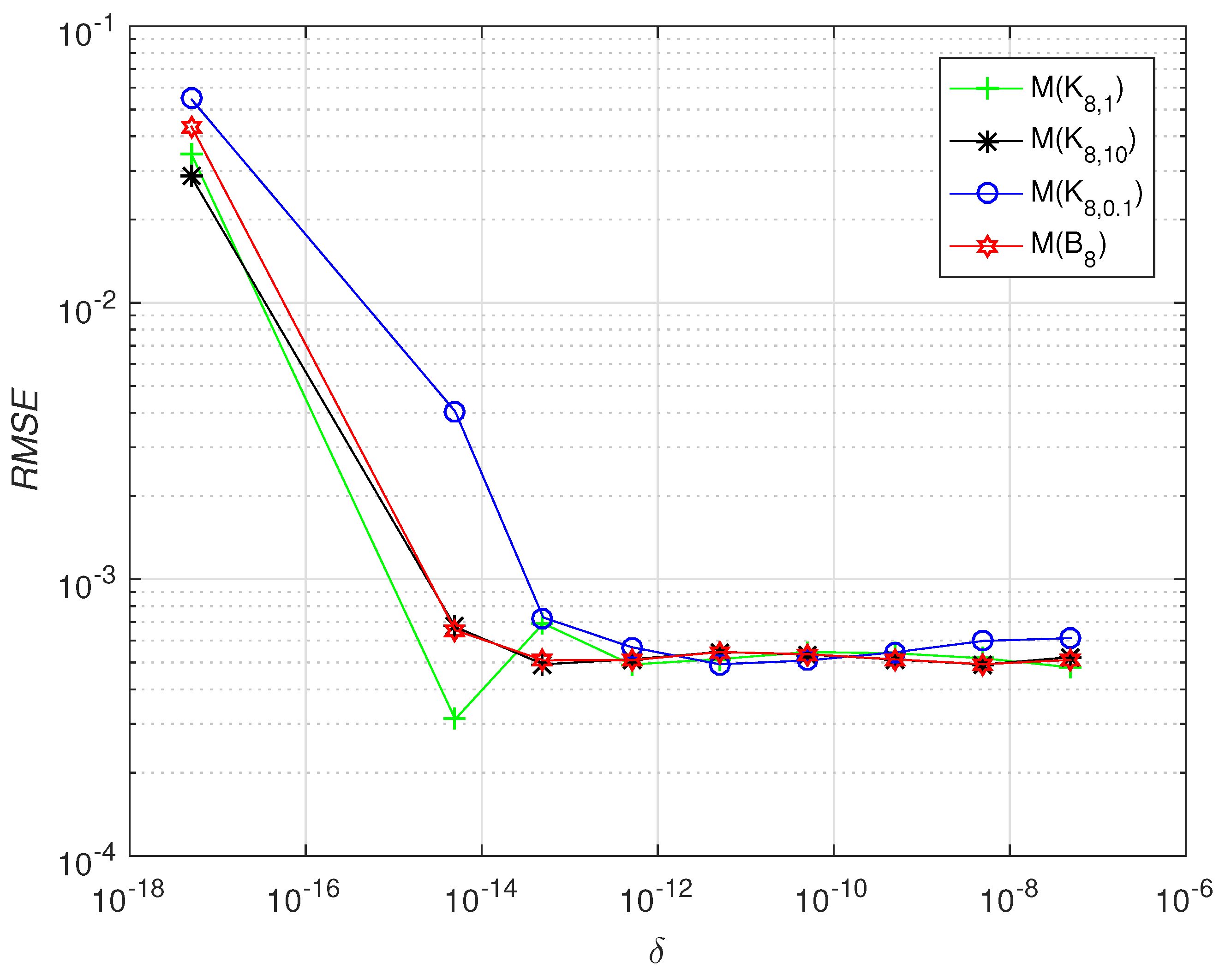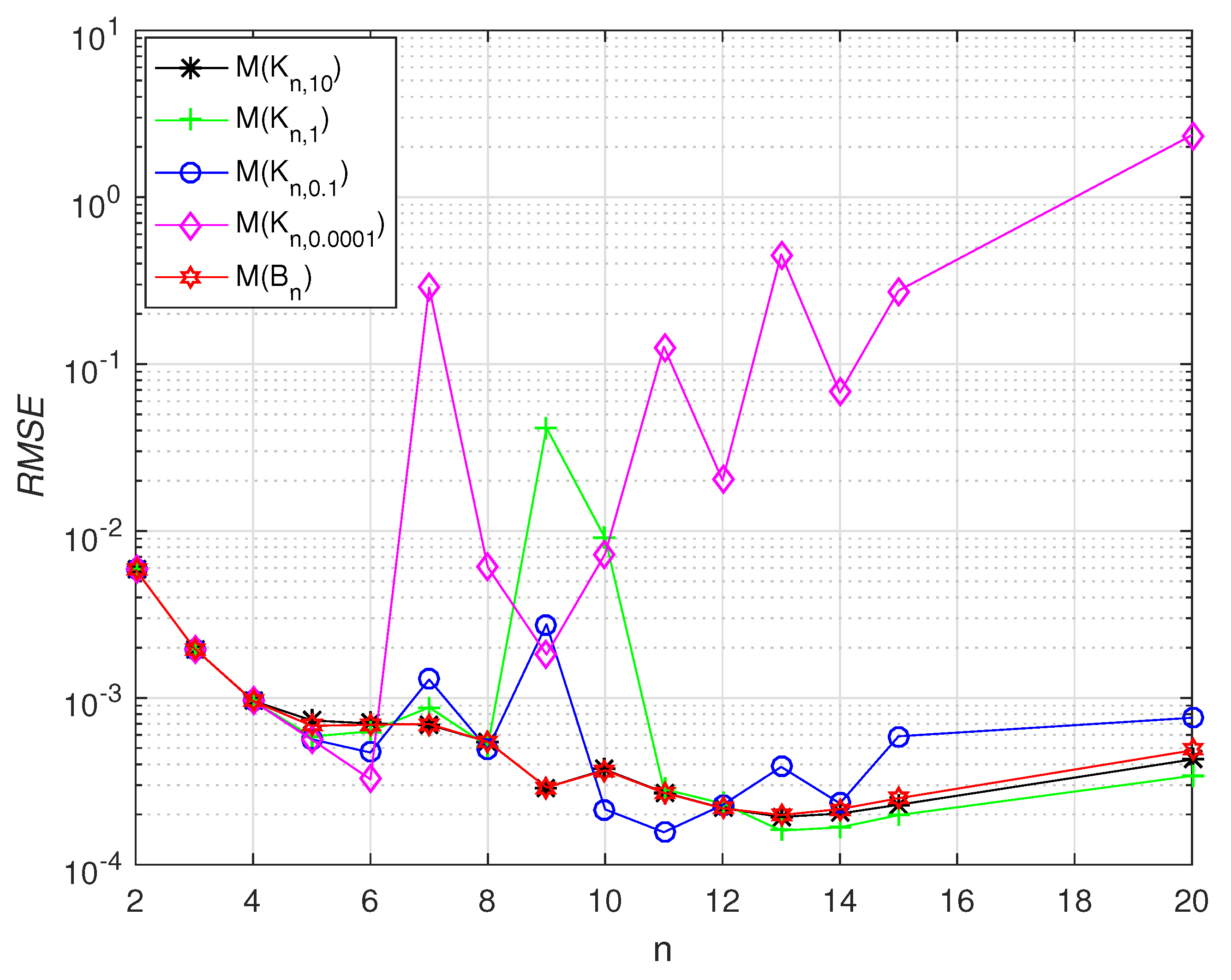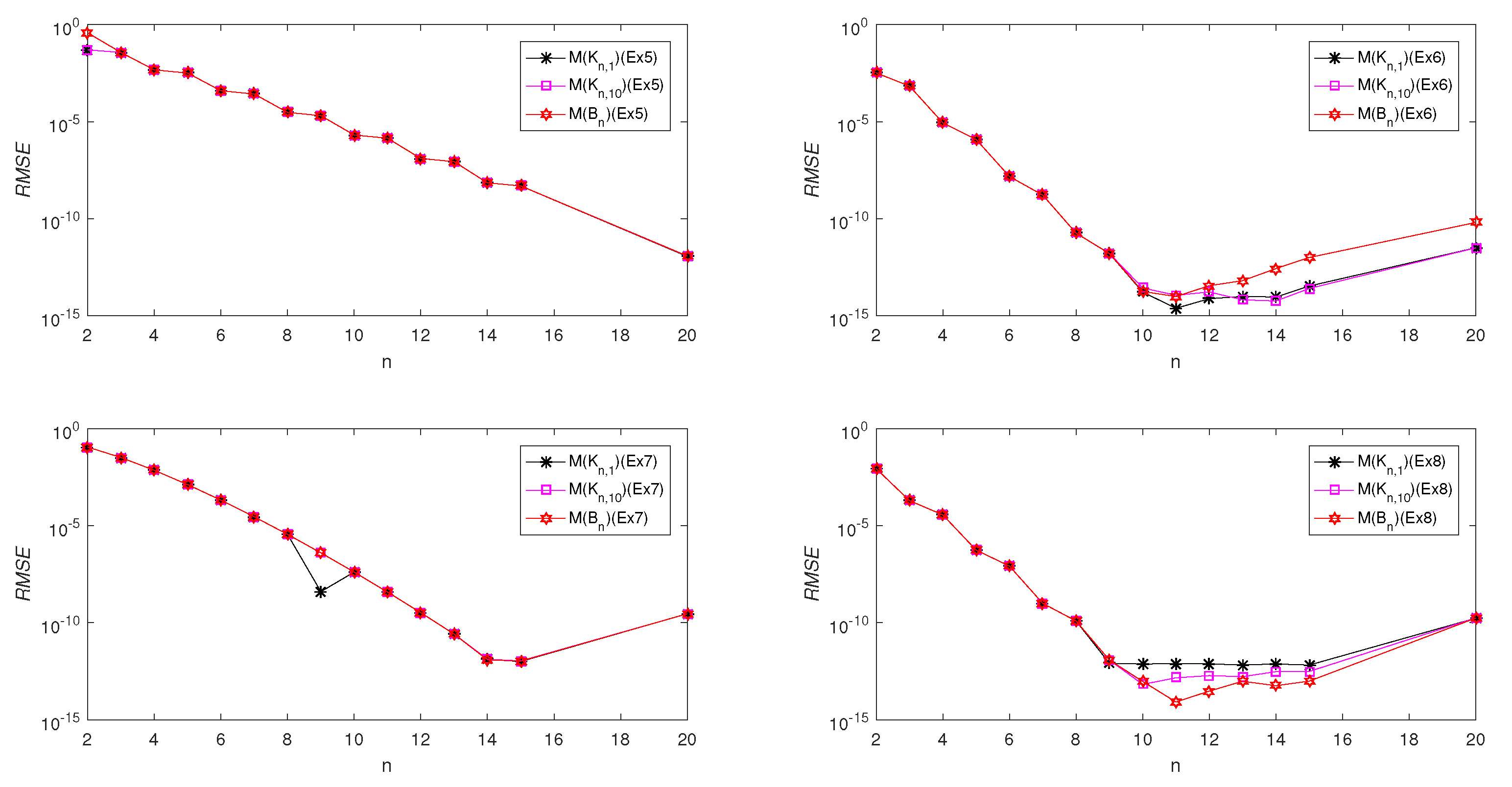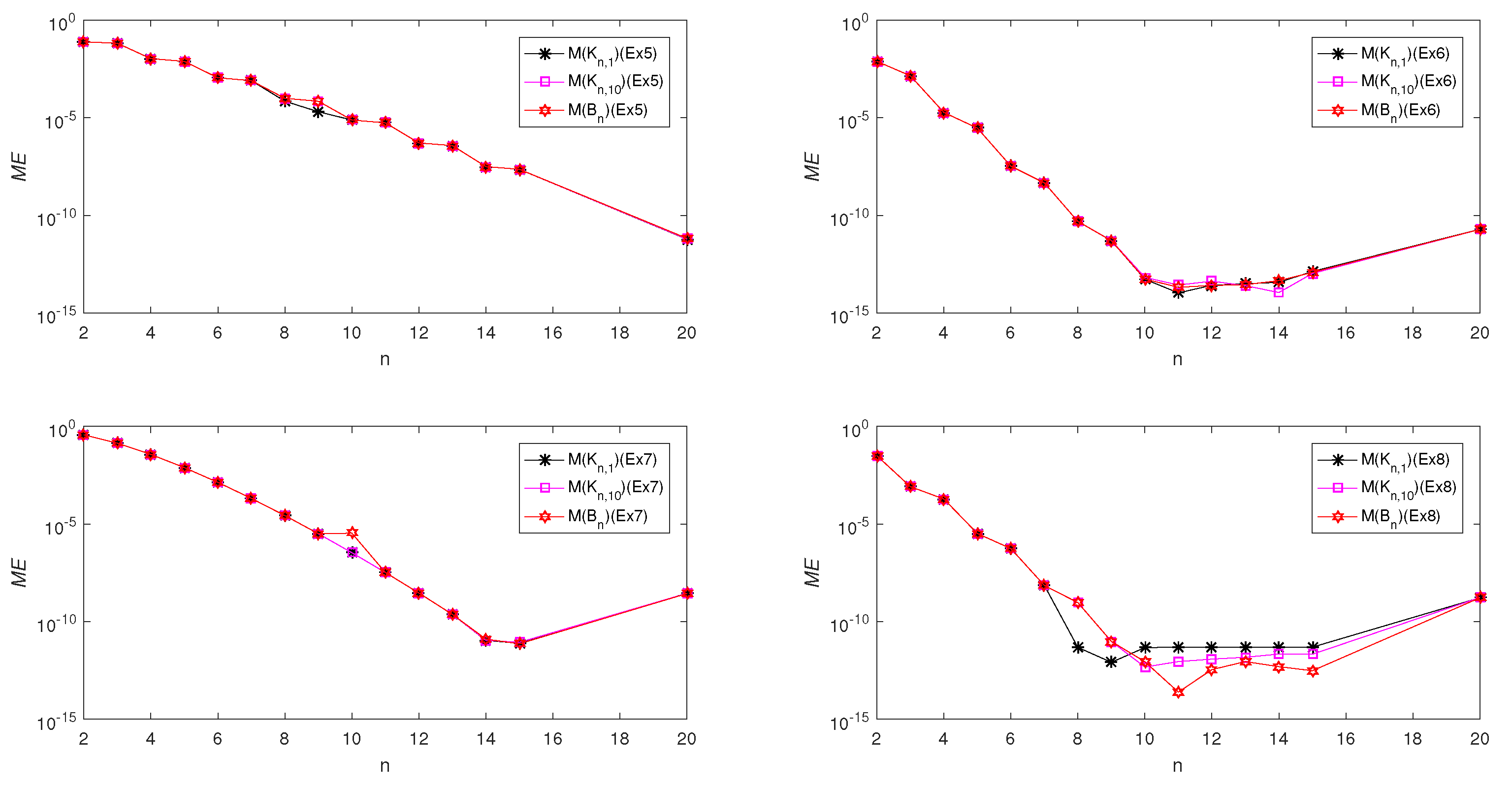1. Introduction
Fredholm and Volterra integral equations of the first kind play an important role in many problems from science and engineering. It is known that the Fredholm integral equations can be derived from boundary value problems with given boundary conditions. For example, Fredholm integral equations of the first kind arise in a mathematical model of the transport of fluorescein across the blood–retina barrier in the transient state and the subsequent diffusion of fluorescein in the vitreous body given in Larsen et al. [
1]. Some other applications are in palaeoclimatology given in Anderssen and Saull [
2], antenna design in Herrington [
3], astrometry in Craig and Brown [
4], image restoration in Andrews and Hunt [
5]. The investigation of Volterra integral equations is very important in solving initial value problems of usual and fractional differential equations arising from the mathematical modelling of many scientific problems, including population dynamics, spread of epidemics, and semi-conductor devices, such as the biological fractional n-species delayed cooperation model of Lotka–Volterra type given in Tuladhar et al. [
6]. Examples of Volterra integral equations of first kind can be extended to mathematical model of animal studies of the effect of the deposition of radioactive debris in the lung by Hendry [
7], the heat conduction problem in Bartoshevich [
8], tautochrone problem of which Abel’s integral equation was derived by Abel [
9], (see also Groetsch [
10]), electroelastic of dynamics of a nonhomogeneous spherically isotropic piezoelectric hollow sphere problem in Ding et al. [
11]. Additionally, the use of a dynamical model of Volterra integral equations in energy storage with renewable and diesel generation has been analysed in Sidorov et al. [
12].
As a classical ill-posed problem, the numerical solution of Fredholm integral equations of the first kind has been investigated by many authors, as a former study by Phillips [
13] and a recent study by Neggal et al. [
14]. The well-known early methods are the regularization methods given with a technique by Phillips in [
13] and the Tikhonov regularization by Tikhonov in [
15,
16]. In the Tikhonov method, a continuous functional is usually used and the minimizer for the corresponding functional is difficult to obtain. Consequently, several methods have been proposed to obtain an effective choice of the regularization parameter in Tikhonov method such as the discrepancy principle, the quasi-optimality criterion (see Groetsch [
17], Bazan [
18] and references therein). Further, in Caldwell [
19], a direct quadrature method and a boundary-integral method were examined for solving Fredholm integral equations of the first kind. Additionally, a regularization technique which replaces ill-posed equations of the first kind by well-posed equations of the second kind was employed to produce meaningful results for comparison purposes. Later, the extrapolation technique by Brezinski et al. [
20] and a modified Tikhonov regularization method to solve the Fredholm integral equation of the first kind under the assumption that measured data are contaminated with deterministic errors was given in Wen and Wei [
21]. Recently, a variant of projected Tikhonov regularization method for solving Fredholm integral equations of the first kind was proposed in Neggal et al. [
14] in which for the subspace of projection, the Legendre polynomials were used.
Early studies for the solution of Volterra integral equations of the first kind involve the high order block by block methods in Hoog and Weiss [
22,
23]. However, these methods suffer from the disadvantage of requiring additional evaluations of the kernels and the solution of systems of algebraic equations for each step. Later, Taylor [
24] used inverted differentiation formulae, which the resulting methods were explicit corresponding to local differentiation formulae. As the author stated “the main disadvantage of this method is that weights must be calculated from the recurrence relation (2.9) and the differentiation formula must be chosen so that the Dahlquist root condition is satisfied”. Integral equations of the first kind associated with strictly monotone Volterra integral operators were solved in Brunner [
25] by projecting the exact solution of such an equation into the space
of piecewise polynomials of degree
possessing jump discontinuities on the set
of knots. Besides, the asymptotic behavior of solutions to nonlinear Volterra integral equations was analysed in Hulbert and Reich [
26]. The future-sequential regularization method and predictor-corrector regularization method for the approximation of Volterra integral problems of first kind with convolution kernel were given in Lamm [
27] and Lamm [
28], respectively. The numerical solution of Volterra integral equations of the first kind by sequential Tikhonov regularization coupled with several standard discretizations (collocation-based methods, rectangular quadrature, or midpoint quadrature) was given in Lamm and Eldén [
29].
New approaches have been developed for the solution of integral equations that use the basis functions and transform the integral equation to the system of linear or nonlinear equations. One of these approaches is the use of wavelet basis. For the solution of Abel’s integral equation, Legendre wavelets were used in Yousefi [
30] and the wavelet basis were used in Maleknejad et al. [
31] for the numerical solution of Volterra type integral equations of the first kind. Another approach is the use of polynomial approximations. In Mandal and Bhattacharya [
32], Fredholm integral equations of the second kind and a simple hypersingular integral equation and a hypersingular integral equation of the second kind were numerically solved using Bernstein polynomials. At the same year, in Maleknejad et al. [
33] numerical solution of linear and nonlinear Volterra integral equations, of the second kind by using Chebyshev polynomials was given. Afterwards, a new approach to the numerical solution of Volterra integral equations by using Bernstein’s approximation was given in Maleknejad et al. [
34].
Recently, exhaustive studies on the use of CESTAC method for the solution of Volterra first type integral equations has been given in Noeiaghdam et al. [
35] in which the control of accuracy on Taylor-collocation method to solve the weakly regular Volterra integral equations of the first kind has been studied. Furthermore, in Noeiaghdam et al. [
36] that the numerical validation of the Adomian decomposition method for solving Volterra integral equation with discontinuous kernels was given.
The need of stable, reliable and time efficient methods for the numerical solution of Fredholm and Volterra integral equations of first kind is the main motivation of contributions. The achievements of the study can be summarised as follows:
1. Using the Modified Bernstein–Kantorovich operators, a numerical approach is developed for the solution of Fredholm and Volterra integral equations of the first kind with continuous and square integrable kernels. Convergence analysis are given assuming that minimum norm least square solution of the obtained algebraic linear systems are obtained by using the exact data, that is to say the Moore–Penrose inverse of the resulting coefficient matrices are computed exactly.
2. Furthermore, regularized integral equations are considered to obtain more smooth solutions especially when high-order approximations are used by Modified Bernstein–Kantorovich operators. The proposed approach is applied by building regularization features into the algorithm and perturbation error analysis are given.
3. Test problems are conducted and theoretical results are justified with the obtained numerical results.
3. Representation of the Operators and Discretization of First Kind Integral Equations
We consider the Fredholm integral equation of the first kind (
FK1)
and Volterra integral equations of the first kind (
VK1)
where
is called the free term while
is called the kernel and
is the unknown function to be determined.
Definition 1. (Groetsch [17,39]) By means of the singular value expansion (SVE) any square integrable kernel can be written in the form The functions are the singular functions of K and they are orthonormal with respect to the usual inner product and the number are the singular values of For degenerate kernels the infinite sum (29) is replaced with the finite sum upto the rank of the kernel. The system is called the singular system of Let be a compact linear operator on a real Hilbert space , taking values in a real Hilbert space . The next theorem is known as the Picard’s theorem on the existence of the solutions of first kind equations.
Theorem 3. (Theorem 1.2.6 in Groetsch [17]) Let be a compact linear operator with singular system In order that the equation have a solution it is necessary and sufficient that (orthogonal complement of the nullspace of the adjoint of ) and On the basis of Theorem 3 we consider the Hypothesis 1 as follows:
Without loss of generality, the solution
f of
FK1 and
VK1 denotes the pseudoinverse solution or the Moore-Penrose generalized inverse solution for
FK1 and
VK1
respectively. Further, in order to determine the effect of
in the numerical solution we represent the Modified Bernstein–Kantorovich operators (
1) for
in the form
where
For the numerical solution of
FK1 and
VK1, we approximate the function
f by using the Modified Bernstein–Kantorovich operators in (
32). We obtain the following equation for
FK1
and for
VK1 we get
Subsequently we take the grid points
and
, where
. Then, the Equations (
35) and (
36) are transformed into algebraic systems of equations
respectively, where the coefficient matrices
A and
have the entries
and
and
are as given in (
33) and (
34), respectively. The coefficient matrices
A and
in (
37) are ill-conditioned matrices and may be rank deficient or even singular matrices. Therefore, we consider the following minimum norm least squares problem for
FK1
and for
VK1Lemma 2. The problems (42) and (43) have the unique minimum norm least squares solutions and respectively. Proof. Proof is analogous to the proof of Theorem 1.2.10 in Björck [
40]. □
Convergence Analysis
By solving the algebraic systems (
42) and (
43) we get a numerical solution of the unknown (
40) and denote this approximation by
Further, let us use
to denote the obtained numerical approximation to
f that is in the implicit form in
and obtained by using the proposed approach. Substituting
in (
32) we get
as
Definition 2. (Definition 1.4.2 in Björck [40]) The condition number of () iswhere , and are the nonzero singular values of Theorem 4. ConsiderFK1andVK1in (27), (28), respectively, and assume that the conditions of theHypothesis Iare satisfied also the solution f belongs to for some then forFK1and forVK1hold true where,and and are given in (6), (7), (23) and (24) respectively. Furthermore, where , and , and . Further, is the approximate solution obtained by the proposed method and and are given in (38) and (39), respectively. Proof. Based on Corollary 1 and the estimation (
22) and taking (
47), we obtain
Next let
for
from (
32) and (
44) and using that
gives
From Theorem 1, the operator
uniformly converges to
f for any
and for any computationally acceptable small
where, as usual,
comes from the uniform continuity of the function
and
is given in (
9) (see Özarslan and Duman [
37]). Therefore, for the numerical solution of
FK1 and
VK1 equations in (
27), and (
28) in accordance we assume
respectively. If we substitute
instead of
in (
53), (
54) we get new function
on the right sides of these equations accordingly,
Thus, for
FK1 using (
53) and (
55) and by taking the grid points
and
, where
we obtain the algebraic system
The minimum norm solution of the least squares problem for (
57) is
Next, consider
FK1 and let
and
then it follows that
then using Corollary 1 and estimation (
21) and (
57) and (
61) and taking
for
and
and using (
48) we get
Substituting (
62) into (
59) and the obtained result in (
52) gives
Further, using the estimations (
50) and (
63) in (
49) and also from
we get (
45). Analogously, for
VK1 it follows that
Using Corollary 1 and estimation (
21) and taking (
48), we obtain
Next, substituting (
65) in (
60) and the obtained result in (
52) we get
Therefore, using the estimations (
50) and (
66) in (
49) follows (
46). □
Remark 1. If the matrix A in (38) and the matrix in (39) are invertible then and and the inequalities (45) and (46) hold true. 4. Regularized Numerical Solution
The numerical solution of the general least squares problems (
42) and (
43) may be extremely difficult because the solution is very sensitive to the perturbations of the coefficient matrices
A and
and the right side vector
B. This is reflected in the fact that
and
are very large and increases as
n increases which is the degree of the constructed polynomial by the Modified Bernstein–Kantorovich operator used for the approximation of the solution. High condition numbers of the matrices
A and
cause rounding errors that prevent the computation of an accurate numerical solution of the problems (
42) and (
43), respectively. Moreover, the obtained discrete problems are always perturbed by approximations such as the integrals given as the entries of
A and
are evaluated numerically. Therefore, even if we were able to solve the discrete algebraic problems (
42) and (
43) without rounding errors we would not obtain a “smooth” solution because of the oscillations in the singular vectors. By a smooth solution we mean “a solution which has some useful properties in common with the exact solution to the underlying and unknown unperturbed problem” as stated in Hansel [
41]. Furthermore, the function
g is typically a measured or observed quantity and hence, in practice, the true
g is not available to us. On one hand, the estimate
of
g satisfying
and
is the priori error level is known(see Tikhonov [
15] and [
16] and Groetsch [
17]). Therefore, we consider the following regularized problems for the Fredholm integral equation of the first kind (
RFK1) (see Tikhonov [
15,
16] and Groetsch [
17])
and Volterra integral equations of the first kind (
RVK1)
It is clear that (
67) and (
68) are second kind Fredholm and Volterra integral equations, respectively. For the numerical solution of
RFK1 and
RVK1 by the proposed method
we take the grid points
and
, where
and is sufficiently small number also
is called the regularization parameter. We assume the following algebraic equations for
RFK1
and for
RVK1
for
Then, the discrete regularized Equations (
69) and (
70) can be presented in matrix form
for the
RFK1 and for the
RVK1 respectively where,
and the vector
which can be written as
such that
is the priori error level
Furthermore,
where
A is the matrix in (
38) and
with the addition of diagonal matrix
and
which is the defect matrix of the numerical errors of the computation of the integrals in (
69) with a predescribed error
depending on
Analogously,
and
is as in (
39) and the matrix
has the defect matrix
of the numerical errors of the computed integrals in (
70) with a predescribed error
Therefore, it is possible to choose
such that
and
Clearly, the numbers
h and
are estimates of the errors of the approximate data
of the problem (
37) for
FK1 and
VK1, respectively, with the exact data
accordingly. Thus, the given regularized systems (
71) uses
h and
explicitly. For the implementation of the approach we have taken
. In this connection, about the remarks on choosing the regularization parameter using the quasi-optimality and ratio criterion, see Bakushinskii [
42] and for the data errors and an error estimation for ill-posed problems see Yagola et al. [
43]. Next, we consider the following general least squares problem for
RFK1
and for
RVK1Theorem 5. (Theorem 1.4.2 in Björck [40]) If and < 1 then Theorem 6. (Theorem 1.4.6 in Björck [40]) Assume that and let Then if the perturbations and in the least squares solution X and the residual satisfy Let
denote the minimum norm solution obtained by solving the general least squares problems (
75) and (
76). Further,
denote the obtained approximation to function
appearing implicitly in (
72). Substituting
in (
32) we get
as
We also present the residual error of the obtained algebraic linear system (
37) for
FK1 by
(
for
VK1). The regularized residual error of the system (
71) for
RFK1 is
(
for
RVK1). Furthermore, the corresponding numerical calculation of the regularized residual error is
(
) accordingly. Next, the following priory bound for the error of the approximation follows.
Theorem 7. Assume that the conditions ofHypothesis Iare satisfied and the solution of (67)belongs to for some Consider the regularized linear system given in (71) where and A is the matrix in (38) and . Furthermore, as in (74) and B is the vector in (41) and Additionally and and let for and , where and Further, If and thenhold true where, is the regularization parameter and are as in (47) and (48), respectively. Furthermore, and are as given in (38). Proof. For
RFK1, it follows that
Based on Corollary 1 and the estimation (
22) by replacing
f with
in estimation (
22) and in (
47) we obtain
Let
then from (
32) and (
44) and using that
follows
where
For the numerical solution of
RFK1 in (
67) we use the grid points
and
, where
We assume
where
gives the average value of
over the interval
If we substitute
instead of
in (
89) we get a new function
on the right side of this equation
Thus, for
RFK1 from (
89) and (
90) we obtain
where,
is as given in (
88). The general least squares problem of (
91) has the minimum norm solution
Then, let
and
for
it follows that
From the assumption that for some it follows that
Let , by taking
for
and
also on the basis of Corollary 1 and replacing
f with
in estimations (
21) and (
48) we obtain
Substituting the estimation (
98) into (
94) and the result in (
87) we get
Inserting (
86) and (
99) in (
85) and on the basis of Theorem 5 and using that
we obtain (
82). The inequality (
83) is obtained by using
and based on the Theorem 6 and the inequality (
78) the first term on the right side of (
100) is obtained as
Next, on the basis of Theorem 5 and using (
93), (
98) and
we get
Inserting the estimations (
101) and (
102) into (
100) gives (
83). To prove the inequality (
84), we use
and based on Theorem 6 and the inequality (
79), the first term on the right side of (
103) is obtained as
The second error term on the right side of (
103) satisfies
using (
102), (
103) and (
104), and that
and from (
81) follows (
84). □
Theorem 8. Assume that the conditions ofHypothesis Iare satisfied and the solution ofRVK1belongs to for some Consider the linear system given in (71) where and is the matrix in (39) and . Furthermore, as in (74) and B is as in (41) and Aditionally and and let for and , where and Further, If and thenhold true where, is the regularization parameter and are as in (47) and (48), respectively. Furthermore, and and are as given in (39). Proof. Proof is analogous to the proof of Theorem 7. □
